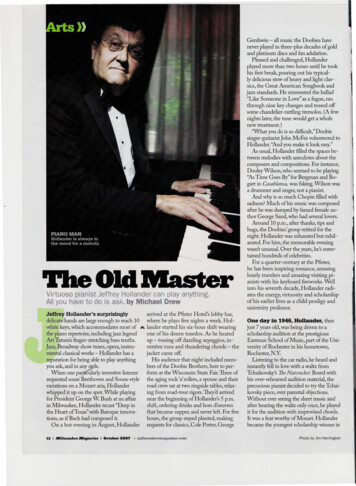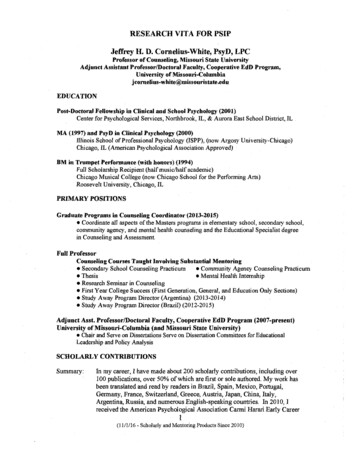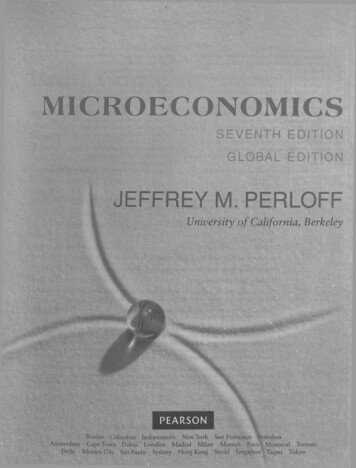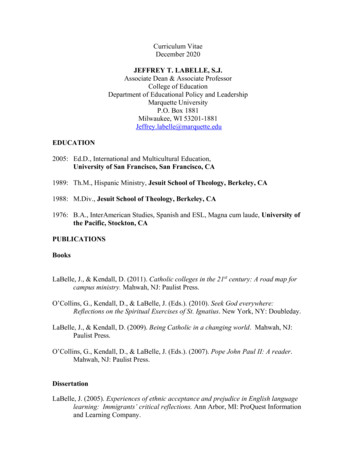
Transcription
CHARLOTTE PERKINS GILMAN"THE YELLOW WALLPAPER"Gil 1. Berman, Jeffrey. "The Unrestful Cure: Charlotte PerkinsGilman and 'The Yellow Wallpaper/" In The Talking Cure: Literary Representations of Psychoanalysis. New York: New York Uni-versity Press, 1985. Pp. 33-59.The Living of Charlotte Perkins Gilman: An Autobiography discussesevents in Gilman's life that are relevant to understanding "The YellowWallpaper." Her father, soon to become a prominent librarian, desertedthe family upon learning that his wife, for health reasons, was advisednot to bear more children. Gilman's mother withheld affection fromCharlotte, one of two surviving children out of four, reasoning that ifthe girl did not expect affection then she could not be hurt in the future(34-35). In response, Charlotte created a dream world that sustained heruntil her mother told her it was wrong to fantasize; the thirteen-yearold girl obeyed (36). Even though she had misgivings about the institution of marriage, she, at twenty-three, wedded Charles Walter Stetson(37) and ten months later bore a daughter and immediately entered intoa severe depression (38). Seeking a change, she left for California andimproved. Upon arriving home and feeling the depression returning,she sought the help of the well-known neurologist S. Weir Mitchell,who prescribed a rest cure (39). For months she complied. Realizing,however, that her condition was deteriorating and that marriage andmotherhood were the sources of her affliction, she divorced her husband (39). Motherhood for Gilman represented "weakness and passivity" (39) and was "the ultimate human sacrifice" (40) Gilman's life affected her writings, both the nonfiction, which gained her fame, and thefiction, especially "The Yellow Wallpaper." Especially relevant to thedevelopment of her theories concerning women and their relationshipto the culture was the trauma caused by her parents' actions (40—45). S.Weir Mitchell, a well known psychiatrist (author of numerous standardmedical texts) and fiction writer (nineteen novels), introduced the restcure, with its components of bed rest and minimum stimulation (46).Although most of his patients were women, he held conservative viewsconcerning them and their roles (47). Information concerning Mitchell'streatment of Gilman comes from her own autobiographical writing (49).64
"The Yellow Wallpaper"65Turning to Mitchell after three years of depression, she entered into therest cure confident that it would alleviate her problems (49). After amonth, Mitchell sent her home with explicit directions, among whichwas "never touch a pen, brush or pencil as long as you live" (50). Afterthree months, she rejected Mitchell's advice and began writing, immediately making gains toward a recovery (50). Perhaps the rest curefailed with Gilman because although Mitchell supported the idea ofmotherhood, she did not: "She was attempting to flee from the domesticprison of the mother's world—the parasitic world of abject dependencyupon men, the depressing routine of endless drudgery, screaming babies, intellectual impoverishment, and helpless resignation. Mitchell'spaternalistic therapy locked her into the mother's role" (50). As Gilmanherself acknowledges, "The Yellow Wallpaper" is a fictionalized version of her breakdown and treatment, with the ending suggesting theoutcome for Gilman had she continued Mitchell's regimen (51). Comparing the autobiographical account of the breakdown and cure withthe fictional version suggests that the short story is more direct andhonest (52). In the autobiography, Gilman describes her husband asbeing without fault, but in the story the narrator's husband, insensitiveand patronizing, forbids her to write (52). For Gilman writing leads tosalvation; when the fictional narrator is denied writing, her recoverybecomes impossible (53). The home, both for Gilman—as evident in herlater tome The Home: Its Work and Influence—and for the narrator, is seenas a prison, as is suggested by the bars on the nursery (53). Thewallpaper, a projection of the narrator's fears, symbolizes herconflicting emotions about motherhood and marriage (53-55). Indeed,"the wallpaper recreates the mother's inescapable horror of childrenand her regression to infancy. The pattern and sub-pattern mirror herterrified identification with the abandoned child and abandoningmother" (55). The wallpaper also suggests the narrator's uneasinessabout sex, an uneasiness also seen in her desire to sleep downstairs in aroom with a single bed (56). Stating that she wrote the story "toconvince him [Mitchell] of the error of his ways" (58), Gilman sent hima copy and later discovered that he subsequently changed his treatment(58). HISTGil 2. Feldstein, Richard. "Reader, Text, and Ambiguous Referentiality ii\ 'The Yellow Wall-Paper.'" In Feminism and Psychoanalysis. Eds. Richard Feldstein and Judith Roof. Ithaca, NY: CornellUniversity Press, 1989. Pp. 269-79.In the manuscript of the story the word "wallpaper" appears threedifferent ways: wall paper, wall-paper, and wallpaper. Editors, however, without justification, have imposed consistency in publication(270). Feldstein argues that the ambiguity is intentional, for the wordrefers to something that "resists analysis" (270), much as the narrator
Charlotte Perkins Gilmanresists her husband's anaylsis. She "produces a feminist counterdiscourse" (271) that opposes his traditional, patriarchal one. Many criticsargue that because the narrator succumbs to madness (as is indicated,for instance, by her gnawing of the bedframe and her crawling aroundthe room), she cannot be a feminist (271). However, the ending seemsironic, and the narrator's madness seems questionable (273). The narrator's actions provide an ironic alternative to the world view of John(273). Although he treats her as a young girl, she responds by resistinghis authority in many ways, feigning sleep at night, pretending not towrite, and refusing to respond to his treatment (273). Reading the storyas a narrative of the mental breakdown of a woman is to accept the authorities' view. But reading it as a narrative of a woman's resistancebrings into question the culture's assumptions about madness andwomen (274). The narrator identifies with other oppressed women asrepresented in the wallpaper (275). Her creeping is a form of resistanceand revenge (275). If the narrator and protagonist are identical, the ending takes on additional meaning, for the protagonist must have recovered sufficiently from her madness in order to write an account of it(277). HIST, FEMGil 3. Golden, Catherine. "'Overwriting' the Rest Cure: CharlottePerkins Gilman's Literary Escape from S. Weir Mitchell's Fictionalization of Women." In Critical Essays on Charlotte PerkinsGilman. Ed. Joanne B. Karpinski. N e w York: G.K. Hall, 1992. Pp.144-58.Charlotte Perkins Gilman was just one of many well-known writers,such as Walt Whitman, treated by S. Weir Mitchell, a famous neurologist and novelist, or treated according to his rest cure therapy, such asVirginia Woolf (144). Gilman not only rejected Mitchell's therapy andhis orders not to write but also created a story that criticized his methods and included him in it (145). Gilman "'overwrote' Mitchell's efforts"to make her into a compliant female patient (145). The rest cure relies onsecluding the patient for six to eight weeks during which time thepatient is allowed no stimulation such as visits from friends, diversions,such as sewing or exercise, and is given a high fat diet (147). Even so,Mitchell's treatment was more progressive than others which relied onovariotomies to relieve depression (146). Although Mitchell did notwrite about Perkins in his fiction, his protagonists, most often passivefemales who depend on strong males, frequently suffer from mentalproblems and are treated by the rest cure (145 7). "The Yellow Wallpaper" takes the same themes and situations found in Mitchell's fictionbut suggests different results and conclusions (151). Gilman's protagonist at the outset is as passive and submissive as Mitchell's heroines, butthrough her madness she gains strength (151). John, her husband, hasthe confidence and authority seen in Mitchell's male characters (152),
"The Yellow Wallpaper"67but his fainting at the conclusion illustrates his failure to understand hiswife (152). The narrator, at first, resists his orders: she secretly w rites inher journal and pretends to sleep (153). Hov ever, because she is entrapped w ithin the house, her recovery is doomed, and she choosesmadness over becoming the submissive w oman that John and Mitchellin his novels and practice prefer (154). The story thus illustrates thedamage done to women who accept the patriarchal view (154). Literature offered Gilman "an opportunity to challenge the restrictions imposed upon women" (155). FEM, HISTGil 4. Hedges, Elaine R. "'Out at Last'? 'The Yellow Wallpaper'after Two Decades of Feminist Criticism." Gritical Essays on Gharlotte Perkins Gilman. Ed. Joanne B. Karpinski. New York: G.K.HaU, 1992. Pp. 222-33.An overview of the criticism of Gilman's story since its re-publicationin 1973 shows that the work is now firmly established in the literarycanon and has been the subject of numerous critical studies with oftenwidely divergent interpretations (222). The two prime areas of contention concern the symbolism of the wallpaper and the meaning of theconclusion, in which the mad narrator creeps over her husband (whohas fainted). The first critical studies considered the story as a woman'sattempt at achieving autonomy while facing limitations set by society.The wall paper, then, becomes a symbol of oppressive traditional gender roles (223) and the conclusion, then, is seen as a victory since thenarrator escapes from them (224). The mid-eighties saw readings basedon the ideas of Jacques Lacan. In these, the narrator does not achieve asemblance of autonomy but instead is oppressed by male discourse,from which she escapes only by moving from the Symbolic realm backinto the Imaginary one of an infant (224-25). These readings considerthe color and odor of the wallpaper; both relate to the culture's repression of female sexuality, resulting in the narrator's inabilty to accept hersexual nature (225). The conclusion is seen in a negative light. The narrator is unable to accept her sexuality, or (if one considers the organicquality of the wallpaper) she is unable to accept motherhood (226). Thenineties brought articles that, challenging the earlier critics, argued that"The Yellow Wallpaper" should not be read as containing a message forwomen. Such a reading, which assumes that all woman share certaincharacteristics, is essentialistic (226). Rather, the story should be read asa product of the culture in which it was produced. Thus, the wallpaperwith its yellow color and strange smell symbolizes the fear at that timeof overwhelming immigration from southern Europe and Asia (227).Other critics discover in the story an indictment of capitalism (227). Nolonger is the narrator seen as on a journey towards selfhood; instead,she is a victim of the "culture of consumption" (227). The changing interpretations reflect the different historical periods of the critics them-
Charlotte Perkins Gilmanselves. The year that "The Wallpaper" was reissued was the year of theRoe V. Wade decision, a period in which women's fight for autonomywas achieving some victories (229). Thus, reading the story as a woman's attempt at creating an identity seemed natural (229). The more recent critical approaches come out of changes in the political and intellectual climate (230). The failure of the Equal Rights Amendment,among other events, helped create a climate of "skepticism or disillusionment about women's power to create and sustain significant political and social change/' and the new (post-structuralist) critical theoriesquestion the concept of identity and the ability to control one's life(230). While some recent critics read the conclusion as the defeat of thenarrator, most see the text as succeeding in its critique of the culture(230). FEM, PSY, PLUR, NHIST, HISTGil 5. Hume, Beverly A. "Gilman's 'Interminable Grotesque': TheNarrator of 'The Yellow Wallpaper.'" Studies in Short Fiction 28(FaU 1991): 477-84.The narrator becomes a grotesque figure, representing the generalstate of women in the nineteenth century { 77). Although the narratorfights the social forces that oppress her, ultimately she is defeated (477).One source of oppression is John, the narrator's husband, who maintains traditionally paternalistic views (478). Although the narratorrebels against him, her rebellion does not lead to freedom but to defeatand insanity (480). Ironically, when John realizes the extent of his wife'smadness, he faints, a stereotypic response of a nineteenth-centurywoman (478). The narrator, untraditionally for women, uses writing totry to understand her difficulties, which she sees as stemming from asituation with gothic qualities (479). The narrator's writing and thewallpaper have certain commonalities: they are both seemingly randomat first reading but on a deeper inspection have a grotesque pattern(480). The narrator wants to interpret the pattern in the wallpaper, but itis difficult to comprehend the grotesque, with its "elements of humorand horror" (483). Eventually in her attempt to unravel the wallpaper'sdesign, she "merges into it, and in effect, becomes it—as the woman inthe wallpaper" (481). Through her intense desire to understand thegrotesque, the narrator becomes part of it herself (482). THEM, HIST,FEMGil 6. Jacobus, Mary. "An Unnecessary Maze of Sign-Reading."Reading Woman: Essays in Feminist Criticism. N e w York:Columbia University Press, 1986. Pp. 229-48.Gilman wrote a gothic tale that "tapped male hysteria about women"(235). The female body is seen by the culture and John as "repugnant,"and thus female desire is oppressed (235). Therefore, when John finallyconfronts his
"The Yellow Wallpaper" should not be read as containing a message for women. Such a reading, which assumes that all woman share certain characteristics, is











